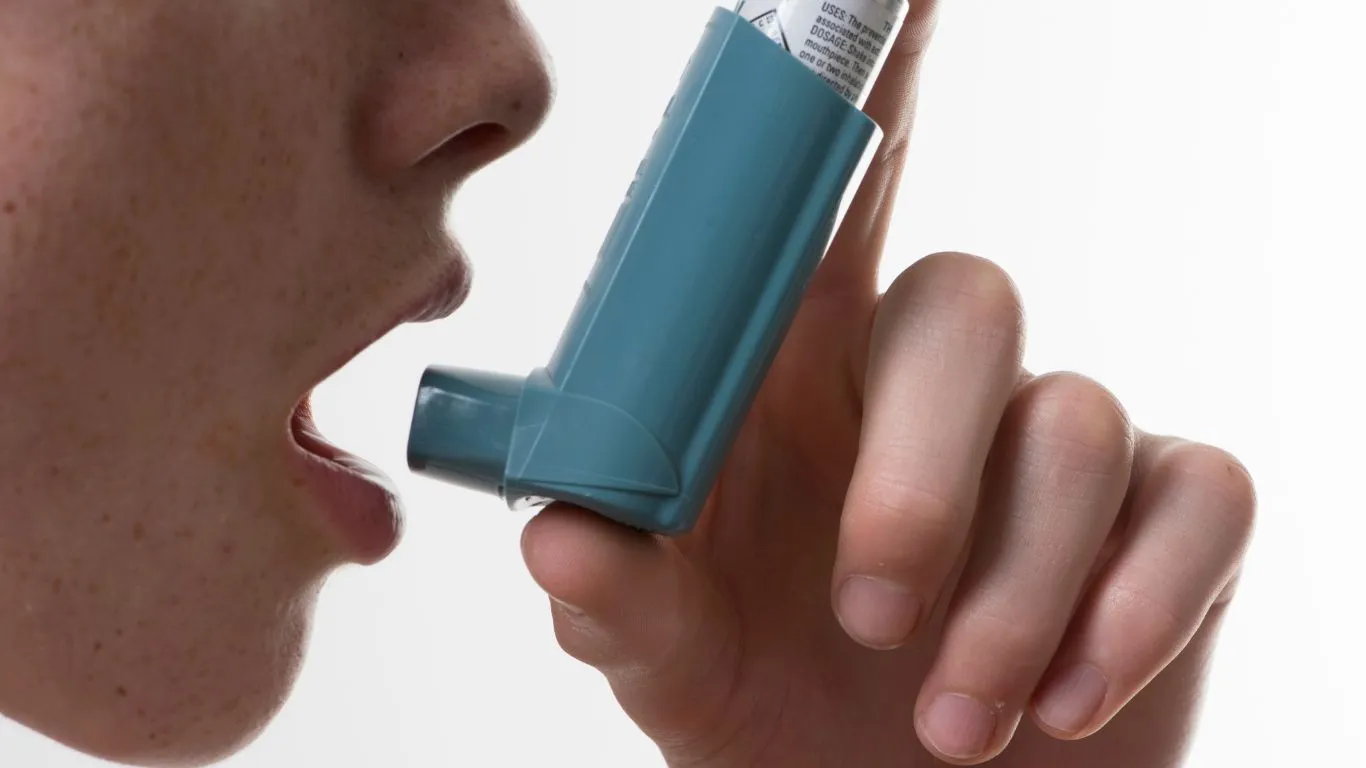The Difference Between Asthma and Pneumonia – What You Need to Know
If you’re trying to figure out what’s going on with your breathing and whether it’s asthma or pneumonia, you’re not alone. It’s tricky to differentiate the two sometimes, but once you know what to look for, it gets a lot easier. Let’s break it down and clear up any confusion!
 When it comes to breathing problems, asthma and pneumonia are two conditions that can mess with your lungs, but they do so in very different ways. It’s easy to get them mixed up, especially when you’re feeling short of breath. But understanding the differences between asthma and pneumonia can help you get the right treatment faster. So let’s dive into the basics and explore how you can tell them apart.
When it comes to breathing problems, asthma and pneumonia are two conditions that can mess with your lungs, but they do so in very different ways. It’s easy to get them mixed up, especially when you’re feeling short of breath. But understanding the differences between asthma and pneumonia can help you get the right treatment faster. So let’s dive into the basics and explore how you can tell them apart.
What Is Asthma?
Asthma is a chronic condition that affects your airways. Basically, it causes your airways to become inflamed and narrow, which makes it harder to breathe. When you’re having an asthma attack, the muscles around your airways tighten, which can lead to wheezing, coughing, and shortness of breath. The symptoms can be triggered by allergens, cold air, smoke, exercise, or even stress. Here’s the thing about asthma – it’s usually something you’ve had for a while. It can start in childhood or develop later, and while it’s not something that goes away, it can be managed with the right medications and lifestyle changes.
Asthma Symptoms:
- Shortness of breath, especially during physical activity
- Wheezing (a whistling sound when breathing out)
- Tightness in the chest
- Coughing, particularly at night or early in the morning
Asthma attacks can be mild or severe, and they might come and go depending on your triggers. The cool part? With the right inhalers or medications, most people can keep it under control. 
What Is Pneumonia?
Pneumonia, on the other hand, is an infection that affects the lungs. It can be caused by bacteria, viruses, or fungi. Basically, it’s when your lungs get inflamed and filled with fluid or pus, making it super hard for your body to get enough oxygen. Pneumonia can hit anyone, but it’s more common in young kids, older adults, and people with weakened immune systems. It can also develop after a cold or flu, making it feel similar to a really bad chest infection. When someone has pneumonia, they typically feel pretty sick, like they have the flu but way worse. The infection can make your lungs sore and cause a buildup of mucus, which makes it difficult to breathe.
Pneumonia Symptoms:
- Fever and chills
- Chest pain (especially when breathing deeply or coughing)
- Persistent cough that might produce mucus
- Shortness of breath and fatigue
- Rapid breathing or heartbeat
- Confusion (in severe cases, especially for older adults)
Pneumonia can be serious, and if left untreated, it can lead to complications, so it’s important to get checked by a doctor if you suspect it.
Key Differences Between Asthma and Pneumonia
Now, here’s where it gets interesting – the symptoms might overlap a little, especially when you’re feeling wheezy and struggling to breathe. But if you look closely, there are some key differences:
1. Cause of the Condition
- Asthma: It’s a chronic respiratory condition caused by inflammation of the airways. You don’t catch asthma; it’s typically something you’re born with or develop over time.
- Pneumonia: This is an infection, often caused by bacteria or viruses, and it’s something you can “catch” from someone else or after an illness like the flu.
2. Symptoms
- Asthma: Symptoms are usually triggered by things like allergens or irritants and can vary in intensity. Coughing, wheezing, and shortness of breath are common.
- Pneumonia: The symptoms are more focused on infection. You’ll likely have a fever, chills, and a persistent cough with mucus, in addition to feeling really tired and unwell.
3. Treatment
- Asthma: Treatment is all about managing symptoms with medications like inhalers (bronchodilators) and corticosteroids. Lifestyle changes (like avoiding triggers) also play a big role.
- Pneumonia: Treatment often involves antibiotics (for bacterial pneumonia), antiviral meds (for viral pneumonia), or antifungals (for fungal pneumonia). You may need to rest and drink fluids to recover, and in severe cases, you might need hospitalization.
4. Duration
- Asthma: It’s a long-term condition. You manage it over time, and symptoms come and go based on triggers.
- Pneumonia: Pneumonia is generally short-term (though it can be severe) and usually clears up within a few weeks with the right treatment.
5. Worsening Symptoms
- Asthma: When asthma worsens, it’s usually due to an asthma attack triggered by something like allergens or exercise. Your breathing becomes labored, and you might wheeze or cough more than usual.
- Pneumonia: Symptoms usually get worse over a couple of days, and you might experience high fever and chest pain. If left untreated, pneumonia can become life-threatening.
How to Tell the Difference
- If you’re wheezing and coughing but not feeling feverish – it could be asthma, especially if the symptoms have been going on for a while.
- If you’re running a high fever and feeling super tired with a persistent cough that’s producing mucus – this is more likely pneumonia, and you should definitely see a doctor.
What To Do if You’re Unsure
If you’re having trouble breathing, whether it’s asthma or pneumonia, it’s always a good idea to reach out to a healthcare provider. They’ll be able to help you figure out what’s going on and get you the treatment you need to feel better. 
Conclusion
Asthma and pneumonia may both affect your breathing, but they’re pretty different when it comes to their causes, symptoms, and treatments. Understanding the difference between the two can help you stay on top of your health and make sure you get the right care. So, if you’re feeling off and struggling to breathe, don’t wait – talk to a healthcare professional to get things sorted out.
Appendices:
References:
For more info on asthma and pneumonia, check out these resources:
- American Lung Association (2024). Understanding Asthma. Read Article
- Centers for Disease Control and Prevention (CDC) (2023). Pneumonia Overview. Read Article
- National Institutes of Health (NIH) (2023). Asthma and Its Management. Read Article
FAQs:
Here are some frequently asked questions about asthma and pneumonia:
- Can asthma lead to pneumonia? Yes, people with asthma are at a higher risk of respiratory infections, including pneumonia. Managing asthma properly can help reduce this risk.
- How can I tell if my shortness of breath is from asthma or pneumonia? If you’re wheezing and have a history of asthma, it’s likely asthma. But if you have a fever, cough with mucus, and chest pain, it might be pneumonia.
- Is pneumonia contagious? Yes, pneumonia can be contagious, especially bacterial and viral forms, so it’s important to practice good hygiene to prevent spreading it.
- Can I treat asthma at home? Yes, with medication and lifestyle adjustments, asthma can usually be managed at home. However, severe attacks may require emergency care.
- How long does pneumonia take to heal? It depends on the type of pneumonia and the person’s health. Typically, with the right treatment, you can start feeling better within a week or two, but recovery may take longer for some.
Disclaimer:
The information provided in this article is for general educational purposes only and should not be used as a substitute for professional medical advice. Always consult a healthcare professional for diagnosis and treatment of any medical conditions.

Bianca Nala is a skilled writer with a deep focus on respiratory disorders. Her articles on Healthusias.com reflect her expertise, providing readers with reliable and engaging insights into respiratory health.














